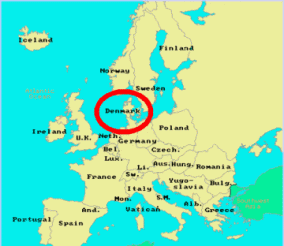
Beginning in less than two weeks, all packages of prescription drugs entering the EU pharma supply chain must contain a 2D barcode encoding the EU serialized ‘Unique Identifier’ (see “The ‘Unique Identifier’ in the EU Delegated Act”). More importantly, all drugs that have an FMD unique identifier on them at the point of dispense after February 9, 2019 must be “verified” and decommissioned through the National Medicines Verification System (NMVS) (see “What’s So Hard About Unique Identifier Verification?” and “Decommissioning Under the FMD/EUDR”). It looks like my prediction of FMD delays was wrong (see “How Will They Delay The FMD?”) but at least Denmark has just moved to solve a serious FMD dilemma with a kind of delay. Let me explain.
There are two FMD startup problems that all countries in the EU are facing. So far, only Denmark has announced plans to address them. First, according to the European Medicines Verification Organization (EMVO) six months ago, less than half of the known drug manufacturers had even started the technical onboarding process—a six month process when things go smoothly (see “How Will They Delay The FMD?”). That strongly implies that a large number of companies are not going to be ready to upload their serialized unique identifier data on time. The second problem is that a significant number of companies began applying the requisite 2D barcode to their packages well in advance of the deadline, but did not upload any data for those unique identifiers through the EU Hub.
What all this means is that, on the day dispensers must start verifying drugs through their NMVS (February 9, 2019), those NMVS will not have the data necessary to verify many of them. If the data in the NMVO doesn’t match the data on the physical product, the product cannot be “verified”, and therefore it must not be dispensed to the patient. This could result in a catastrophe where a large percentage of serialized drugs become undispensable overnight on the go-live date.
This week, the Danish Medicines Agency (DMA) announced a plan aimed at addressing these problems (see the last section on the linked page). What they are saying is, if a point of dispense verification comes through their NMVS for a product that they do not have the data for, they will add the product’s shelf life to the date February 9, 2019 to determine whether or not to verify it. If the current date falls within that timeframe, the product will be verified as if they did have the matching data.
What that means is, they will not fail any drugs after February 9, 2019 as long as they are within their shelf life after that date, even if the manufacturer has failed to upload the data. This is an effective delay in enforcement at the point of dispense, which will avoid loss of use of drugs that are late—but only for a period of time depending on the shelf lives of each individual product. According to my understanding, this will fall between 3 months and 5 years.
Of course, this opens the door to criminals who could take advantage of the delay. In fact, the only entities that cannot benefit from this type of delay are the drug manufacturers. They are still obligated to apply the unique identifier and begin uploading the data as of the original deadline.
What about the obligation to upload data for drugs serialized and introduced into the market before the deadline? The brand new version 13 of the EC Safety Features Questions and Answers contains this as a new question/answer:
“8.9. Question: Should marketing authorisation holders upload the unique identifiers for products with 2D barcodes released for sale or distribution before 9 February 2019?”
“Answer: Yes. According to Article 48 of Commission Delegated Regulation (EU) 2016/161, medicines released for sale or distribution before 9 February 2019 without a unique identifier may remain on the EU market until their expiry date, as long as they are not repackaged or relabelled after that date. This transitional measure does not apply for products which were released before 9 February 2019 with a unique identifier. The unique identifiers for such products should be uploaded to the system before the entry into application of the new rules (9 February 2019). This should help to avoid alerts for genuine products released before 9 February due to lack of data in the repository.”
“This should help avoid alerts for genuine products…“. Yeah, if the manufacturer has that data, and if they upload it, if they are even onboarded yet. That’s a lot of ‘ifs’.
Good for Denmark for recognizing this problem and for trying to work around it. I wonder what the other EU countries are going to do about this problem?
Dirk.
